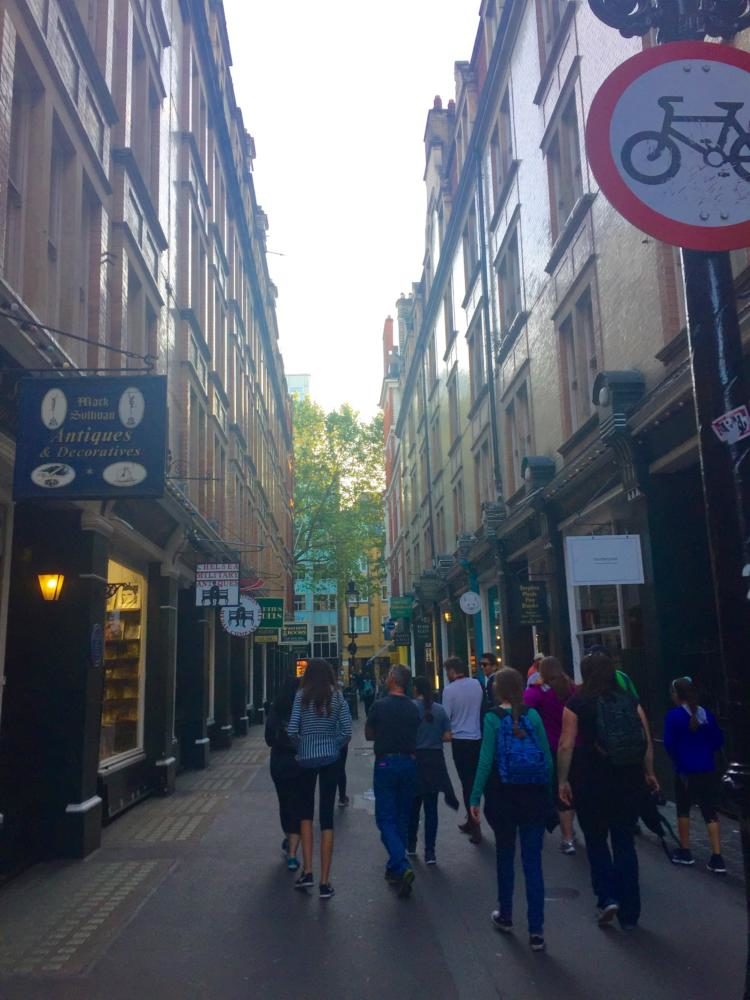A Street of Magic and Creativity
Cecil Court has many old bookshops and antique stores lining the street. Some of the visitors from the Harry Potter tour walk around, enjoying the character of each building and glancing in the shop windows.
May 5, 2017
If you’ve ever been to London, you’ve probably visited the famous Big Ben or the historic Westminster Abbey; but as you drive on those big red buses or take taxis from one tourist spot to the next, do you ever stop to look at the narrow little streets with few people in between?
One such place is Cecil Court, which has few visitors, but a lot of history and character.
Located just meters from Leicester Square and Covent Garden, you’d miss it if you weren’t looking close enough. Cecil Court is a narrow pedestrian street lined with old bookshops and locally owned cafes. The road retains its cobbled brick surface on the sides to maintain the antiquity of the street.
Named after Robert Cecil in the 17th century, Cecil Court was originally designed to fill in some empty space between Leicester Square and Covent Garden. Yet as the city grew, more and more people began to use this street to cut across from one place to another.
Throughout its history, Cecil Court has experienced its share of events and exciting stories. Most famously, Wolfgang Amadeus Mozart briefly lived in a house on this street during his younger years where he supposedly began to compose his first symphony. Mozart performed his pieces for the royal family during his time living on Cecil Court. While creating his symphonies, Mozart and his family shared a house with a barber and paid weekly amounts for their lodgings.
Nearing the end of the 18th century, a fire swept through Cecil Court and destroyed several houses. At this time, Cecil Court had built up a reputation of having loud, rude, and trouble-making people living there. As the fire spread, several people looted some houses of valuables. After the fire was controlled, many homeowners on Cecil Court were brought in to be questioned, many having to pay fines or serve time in jail for robbery.
Today, many bookshops and antique stores fill the buildings that once stood as homes. These bookstores aren’t like everyday bookstores, however, for they contain first edition copies of books ranging from Alice in Wonderland to Sherlock Holmes. Collectibles and other fascinating items sit in the windows of antique shops, many displaying high prices and dates from over a century ago.
If you take the Harry Potter tour where a guide shows all the filming locations throughout London, Cecil Court is the last location of the tour.
After ending on this narrow street, the animated guide, wearing a red and yellow scarf and waving around a wand, points to one of the bookshops. “Here, some of London’s notorious occultists met up in that building. One room in the building was completely covered in mirrors so to discover other-worldly phenomena to prove magic exists.”
Everyone turned to look at the old house, about four stories tall, trying to locate the mirrored room.
“It was even suspected Sir Arthur Conan Doyle took part in this organization for some time. After his son died in World War I, Sir Arthur sought out ways to contact the dead, more specifically through séances, and so he became involved in occultism to try and reconnect with his dead son.”
Several people made some surprised gestures.
One of the older bookshops, Watkins Books, often had customers like WB Yeats and Aleister Crowley, the infamous occultist and magician. Established in 1897, Watkins Books gained notoriety for selling books about dark magic, occultism, and mysticism; and to this day it continues to carry the many stories of authors, poets, occultists, and occultist authors who visited this bookshop.
Not only was Cecil Court a hub of activity for occultists, but it was also an inspiration for writers, painters, and artists.
Harry Potter author J.K. Rowling, as the tour guide put it “would come down Cecil Court all the time, and it was this street that inspired her to create Diagon Alley.”
Rowling isn’t the first author to get inspiration from Cecil Court, however. Poets like Robert Frost and Edwin Thomas would often meet up for lunch at one of the few cafés near and on Cecil Court to catch up on current events. The street attracted artists, as well. Painter William Hogarth lived on Cecil Court for some time, enduring the same fire that ripped through the street and killed his mother in the process.
The unique lure of Cecil Court continued well into the 19th century, when early British films and film companies used the eeriness and beauty of the street for movies and commercials. Businesses like the Pioneer Film Company were based on Cecil Court and thrived for some time; and movies and commercials up to 2006 have flowed from this very street.
No matter the use or inspiration, Cecil Court has some unbreakable attraction for creative minds; ever since it was made, the street has grabbed the attention of writers, artists, and occultists. There must be some charm or reason as to why people come back.
As W.B Yeats said, “The world is full of magical things, patiently waiting for our senses to grow sharper.”
Maybe Cecil Court is a magical place for people with imaginative minds and sharp senses, drawing those who seek a place where the fun resides beneath the surface.






